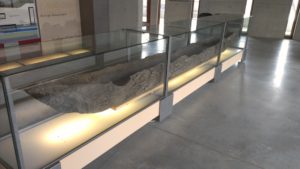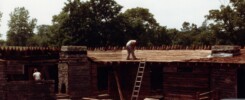
Technical Data:
Found: On the Big Blue River in the Armco Steel Complex
Age: Most likely 200 years….earliest possible date 1690
Material: Black Walnut
Length: 16 feet, 6.5 inches
Estimated freight capacity: Approximately one ton
Origin: Believed to be Euro-American
Method of Construction: Evidence shows use of iron tools
In early 1992, Dennis Reed, a contract truck driver working on the Big Blue River channelization project near Truman Road, contacted Jackson County Parks and Recreation and indicated that he had retrieved what he believed to be a dugout canoe from a debris pile. He offered to donate the canoe to the Park Department. An inspection by staff indicated that the object was, in fact, a dugout canoe consistent with the type and construction common to Western Missouri. Further inspection indicated that iron tools were probably used in the shaping of the canoe.
The canoe was a basic form of transportation and was common to both the Native American and early European frontiersmen engaged in the fur trade. In consideration of the importance of the fur trade to the mission of Fort Osage it was decided that the canoe would be a significant contribution to the interpretive displays at the fort.
Research indicates that wood objects which have been water immersed for extended periods will rapidly disintegrate when exposed to air. Of the major excepted forms of wood preservation, the polyethylene glycol was chosen for this project. The object to be preserved is totally immersed in a solution of polyethylene glycol (peg) which is kept at a constant temperature and gradually increased in concentration. The peg gradually permeates the entire object and displaces the absorbed water in the wood cell structure. After immersion, the object is removed from the solution and a gradual dry out is undertaken to bring the object back to the ambient humidity.
Since the canoe had been already exposed to air for several weeks before it was donated to the County, the first step in conservation was to re-immerse the canoe to prevent further deterioration. After transport to the Fort, the canoe was immersed in a water solution in a temporary tank made of wood and a plastic liner. This suspended further damage and allowed the staff to formulate a plan of preservation. Various agencies and individuals who had previous experience in wood preservation were contacted. Among those were the Smithsonian, National Park Service, Missouri Department of Natural Resources, and the Maryland Department of Natural Resources.
The restoration plan included:
- The canoe was subjected to clean water “flush”, a constant flow of clean water removed as much sediment as possible.
- The canoe was shown during the 1993 Kansas City Boat Show at Bartle Hall. This was the last public showing of the canoe until the preservation process was completed. The Kansas City Boat Show Company provided the initial supply of polyethylene glycol.
- The canoe was then submerged in a new tank with a 5% solution of peg. Electric heaters maintained the solution temperature at approximately 100 degrees Fahrenheit and circulation pumps maintained solution movement. Additional peg was added on a set schedule over an extended period until the solution was at 50%.
- The canoe was removed from the solution and an enclosure was constructed around the canoe to retard rapid dehydration. Temperature and humidity gauges monitored levels.
A special display enclosure was constructed for public display in the Visitor’s Center at Fort Osage. After a private preview of the canoe for The Native Sons of Kansas City, who were major benefactors to the project, the canoe will be on public display.
The following individuals and organizations contributed to the project:
The Native Sons of Kansas City Dennis Reed
Smithsonian Institute
Kansas City Boat Show Company Growth Industries
Friends of Fort Osage
Hinckley & Schmitt
Missouri Free Trappers
The National Park Service
Missouri Dept of Natural Resources
Wyandotte County Museum
Leavenworth Museums
The Arabia Museum
Maryland Dept of Natural Resources
Union Carbide and Borax Corp
Mississippi Dept of Archives and History

